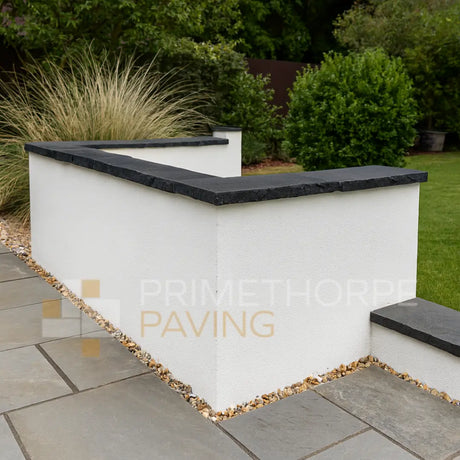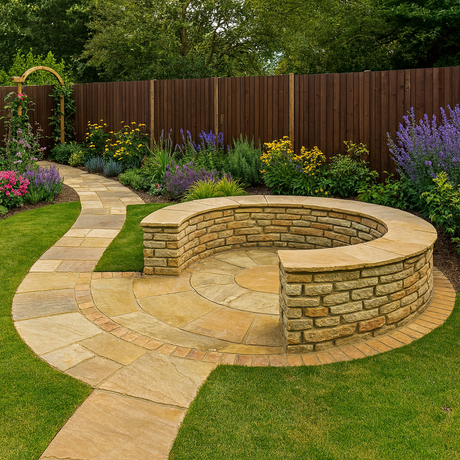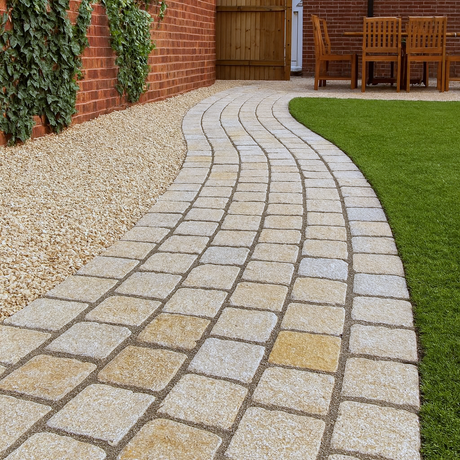Fireplace Hearth Regulations & Size Guide (UK): What You Must Know
The world of home renovation is exciting. Whether you’re refreshing your walls with new paint, adding wallpaper, or upgrading flooring, most projects come with low risk… if you don’t like the result, you can always change it.
Fireplaces are different. Because they involve heat and flame, the margin for error is much smaller. A hearth that’s the wrong size, thickness, or material isn’t just inconvenient; it can compromise safety. That’s why UK Building Regulations include specific rules for hearths; rules that every homeowner should understand before buying.
This guide takes you beyond the legal requirements. We’ll cover the minimum sizes and thicknesses you need to know, show you what’s commonly available off the shelf, and explain when a custom hearth might be necessary. Along the way, you’ll see how different materials affect both compliance and style, with links to our full Fireplace Hearths collection so you can explore your options.
By the end, you’ll know exactly what’s required, and how to make sure your new hearth is both compliant and perfectly suited to your home.
Need a Compliant Hearth Fast?
Explore our ready-made and cut-to-size hearths to find the perfect fit.
Browse HearthsWhy Hearth Regulations Matter
Fireplace hearth regulations may look like a checklist of numbers, but they exist for three very practical reasons:
Fire Safety
Most flooring isn’t built to handle the sustained heat of a fire or stove. Vinyl, laminate, and even timber can warp or burn if exposed. A hearth creates a safe, heat-resistant zone that prevents this damage and catches embers or ash that fall from the fire.
Legal Compliance
Hearth sizes and thicknesses are governed by UK Building Regulations (Document J). Meeting these standards isn’t optional; it’s a legal requirement when installing or replacing a fireplace.
Better Aesthetics
Regulations also ensure proportion. A hearth that’s too small looks out of place, while the right size frames your fireplace naturally. Compliance isn’t just about safety; it often produces the most visually balanced result.
If you’re planning a straightforward installation, browse our Ready-Made Hearths, or for trickier fireplaces or bespoke projects, you can explore our Cut-to-Size Hearths.
UK Hearth Regulations: Sizes & Thickness
When it comes to hearths, size really does matter. The rules are designed to make sure your fireplace operates safely, no matter what type of stove or fire you’re using. Understanding these minimum requirements is the first step toward choosing the right hearth.
Minimum Hearth Size Requirements
For most solid fuel appliances in the UK, the hearth must:
- Extend at least 150 mm to each side of the appliance.
- Project at least 300 mm in front of the appliance.
- Cover a minimum plan area of 840 mm x 840 mm.
If your stove is free-standing and not installed in a recess, these clearances still apply. The goal is simple: create enough space so that any sparks, ash, or heat land safely on a non-combustible surface.
Hearth Thickness Requirements
Thickness is just as important as footprint. The general rule is:
- 12 mm: Allowed only if the appliance is certified not to raise the hearth surface above 100°C. This usually applies to modern gas or electric fires that give off radiant heat but don’t transfer much to the floor. These are the exception, not the rule.
- 20–30 mm: Suitable for the majority of wood-burning stoves and multifuel stoves. At Primethorpe, our hearths start at 20 mm because this is the most practical thickness for real-world use.
- 50 mm+: Recommended for open fires or oversized appliances. The thicker stone helps manage both heat and weight, giving you peace of mind.
Your choice of material also plays a role. Denser stones like Granite or Slate can perform well at slimmer profiles, while softer stones like Sandstone and Limestone often need to be cut thicker for strength.
If you’re unsure which thickness applies to your stove, start with our Custom Cut-to-Size Hearths. Our team can advise you based on the specific appliance you’re installing.
Standard Hearth Sizes
Natural stone can be cut into almost any shape, but over the years we’ve learned that most UK fireplaces fall into a handful of common dimensions. By focusing on these, we’re able to keep our ready-made hearths affordable and in stock, while still covering the majority of use cases.
| Size (mm) | Typical Use Case |
|---|---|
| 1200 x 600 | Standard rectangular fireplaces |
| 900 x 900 | Square or corner fireplaces |
| 1500 x 1000 | Larger living room fireplaces |
These sizes were chosen because they satisfy most installation needs without modification. In many cases, one of these will fit your fireplace perfectly. In others, only minor trimming or adjustment is required.
For more complex layouts, like T-shapes, these rectangular blanks can be used as the starting point. With additional cutting or joining, they can be adapted to create almost any design.
Browse our full Ready-Made Hearths collection to see the range of standard sizes available today.
Not Sure Which Size Fits?
Our cut-to-size service ensures compliance and a perfect fit for any fireplace.
Get a Custom QuoteWhen You’ll Need a Custom-Sized Hearth
While standard sizes cover a lot of ground, many fireplaces simply don’t fit the mould. In fact, we sell more custom hearths than ready-made ones because every home, and every stove, has its quirks.
The most common reasons for going custom are:
-
T-shaped hearths: A popular choice for people who want the hearth to extend further into the room, creating a defined safe zone in front of the stove.
-
Unique design preferences: Raised hearths, extra-deep surfaces, or proportions tailored to your interior style.
-
Oversized stoves: Larger burners need more clearance, so standard blanks often won’t cut it.
Non-standard fireplaces: Period homes, asymmetrical openings, freestanding island fireplaces, or log burners positioned away from a recess.
In each of these cases, a bespoke cut ensures your hearth not only complies with regulations but also complements your room layout.
Use our Cut-to-Size Hearths builder to explore nearly 20 shape options, input your measurements, and get an instant price online.
Choosing the Right Material
Once you know the size and thickness you need, the next decision is material. Each stone has its own properties, and while compliance is the priority, style and durability also play a big role in your choice.
Slate
Versatile, strong, sleek—safe for most projects at 20 mm.
Granite
Dense and durable, ideal when restricted on height but need strength.
Limestone
Lighter look, but should be cut thicker (30 mm+) for bigger stoves.
Sandstone
Rustic and characterful, but softer—needs extra thickness.
Explore our full material ranges: Slate Hearths, Granite Hearths, Sandstone Hearths, Limestone Hearths.
Quick Tips for Measuring
Getting hearth measurements right is critical. Unlike paint or carpet, stone isn’t forgiving. If it arrives cut to the wrong size, there’s little you can do without starting over. A tape measure and some patience are your best tools here.
Start with the floor level. Decide whether you want your hearth flush with the flooring or raised above it. That choice directly affects how much thickness you can work with. If you’ve only got limited clearance, denser stones like granite or slate allow you to keep the profile slim while still supporting your stove.
Next, remember the expansion gap. Stone expands fractionally as it heats. If your hearth sits hard against a wall, that expansion can cause cracks. Leave at least 5 mm, ideally closer to 10 mm, between the hearth and any wall it touches.
Finally, don’t forget about the stove door swing. Open the door fully and measure its reach. Your hearth should extend far enough forward to catch any ash or embers that fall when you refuel. This small step prevents messy and potentially hazardous spills onto your flooring.
Quick Checklist
- Measure twice – write everything down.
- Allow 5–10 mm expansion gap against walls.
- Check stove door swing and projection.
- Factor in thickness if flush with floor.
The Next Step
Once you’ve got accurate measurements, you’re already most of the way there. From here, the process is simple:
If your numbers line up with standard dimensions, our Ready-Made Hearths offer a fast, affordable solution with quick turnaround times.
If your fireplace is unique - whether you need a T-shape, a raised platform, or just something bigger - our Custom Cut-to-Size Hearths give you complete flexibility. You can input your dimensions online, choose your shape, and get an instant price.
Still not sure which way to go? Use our hearth quote form and one of our specialists will walk you through the options.
Final Thoughts
Fireplace regulations can feel intimidating, but they’re designed to keep your home safe while making sure your fireplace looks balanced and professional. Once you know the required clearances, thickness, and material options, the rest is simply about choosing what works best for your space.
At Primethorpe Paving, we’ve spent decades cutting and supplying hearths for every kind of home: from standard living room fireplaces to bespoke island features. Whether you choose an off-the-shelf size or a fully custom design, every hearth is crafted to meet regulations and provide years of reliable service.
Explore our full Fireplace Hearths collection today, or get in touch for expert advice on your next project.
Ready to Order?
Explore our Fireplace Hearths collection or request a custom quote today.
Explore Fireplace Hearths





